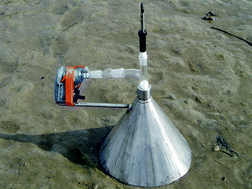Analysis of volatile organic compounds (VOCs) in sediments using in situ SPME sampling†
Abstract
A new method of determining the composition of sediment/soil gases and their volatile organic compound (VOC) content is described. VOCs were collected in situ from intertidal sediments in the Menai Strait and surrounding areas. The sampling was performed using a portable sampler comprising a funnel coupled to a SPME fibre. Gases were extracted from the sediments using a small vacuum pump pulling 100 mL min–1 at atmospheric pressure. Sixty one different compounds were detected in the samples, and their fluxes and concentrations were determined. The compounds were classified into groups: halogenated, sulfur containing compounds,


 Please wait while we load your content...
Please wait while we load your content...